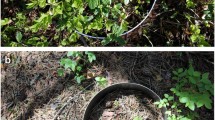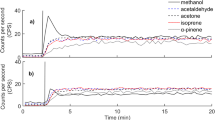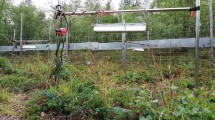Abstract
Background and aims
Mountain birch forests dominate in the Subarctic but little is known of their non-methane biogenic volatile organic compound (BVOC) emissions. The dwarf shrubs Empetrum hermaphroditum, Vaccinium myrtillus and Vaccinium uliginosum co-dominate in the forest floors of these forests. The abundance of these three dwarf shrubs relative to each other could be affected by climate warming expected to increase nutrient availability by accelerating litter decomposition and nutrient mineralization. We 1) compared the BVOC emission profiles of vegetation covers dominated by E. hermaphroditum and V. myrtillus plus V. uliginosum in a subarctic mountain birch forest floor, 2) distinguished the BVOCs emitted from plants and soil and 3) measured how the BVOC emissions from the different vegetation covers differed under darkness.
Methods
BVOCs were sampled during two growing seasons using a conventional ecosystem chamber-based method, collected on adsorbent and analyzed with gas chromatography–mass spectrometry.
Results
High abundance of E. hermaphroditum increased the sesquiterpene emissions. Soil released fewer different BVOCs than controls (i.e. natural vegetation) but the total emission rates were similar. Darkness did not affect the emissions. Carbon emitted as BVOCs was less than 0.2% of the CO2 exchange.
Conclusions
Our results suggest that sesquiterpene emissions from subarctic mountain birch forest floors would be reduced following an increased abundance of V. myrtillus and V. uliginosum with climate change because these species respond rapidly to increased nutrient availability.



Similar content being viewed by others
References
Aaltonen H, Pumpanen J, Pihlatie M, Hakola H, Hellén H, Kulmala L, Vesala T, Bäck J (2011) Boreal pine forest floor biogenic volatile organic compound emissions peak in early summer and autumn. Agric For Meteorol 151:682–691
ACIA (2005) Arctic Climate Impact Assessment. Cambridge University Press, New York
Bäck J, Aaltonen H, Hellén H, Kajos MK, Patokoski J, Taipale R, Pumpanen J, Heinonsalo J (2010) Variable emissions of microbial volatile organic compounds (MVOCs) from root-associated fungi isolated from Scots pine. Atmos Environ 44:3651–3659
Bäckstrand K, Crill PM, Mastepanov M, Christensen TR, Bastviken D (2008) Non-methane volatile organic compound flux from a subarctic mire in Northern Sweden. Tellus 60B:226–237
Beckmann M, Lloyd D (2001) Extraction and identification of volatile organic substances (VOS) from Scottish peat cores. Atmos Environ 35:79–86
Bliss LC, Matveyeva NV (1992) Circumpolar arctic vegetation. In: Chapin FS III, Jefferies RL, Reynolds JF, Shaver GR, Svoboda J (eds) Arctic ecosystems in a changing climate, an ecophysiological perspective. Academic, San Diego, pp 59–90
Bret-Harte MS, Mack MC, Goldsmith GR, Sloan DB, DeMarco J, Shaver GR, Ray PM, Biesinger Z, Chapin FS III (2008) Plant functional types do not predict biomass responses to removal and fertilization in Alaskan tussock tundra. J Ecol 96:713–726
Callaghan TV, Björn LO, Chernov Y, Chapin T, Christensen TR, Huntley B, Ims RA, Johansson M, Jolly D, Jonasson S, Matveyeva N, Panikov N, Oechel W, Shaver G, Elster J, Jónsdóttir IS, Laine K, Taulavuori K, Taulavuori E, Zöckler C (2004) Responses to projected changes in climate and UV-B at the species level. Ambio 33:418–435
Chen F, Al-Ahmad H, Joyce B, Zhao N, Köllner TG, Degenhardt J, Stewart CN Jr (2009) Within-plant distribution and emission of sesquiterpenes from Copaifera officinalis. Plant Physiol Biochem 47:1017–1023
Duhl TR, Helmig D, Guenther A (2008) Sesquiterpene emissions from vegetation: a review. Biogeosciences 5:761–777
Faubert P, Tiiva P, Rinnan Å, Michelsen A, Holopainen JK, Rinnan R (2010a) Doubled volatile organic compound emissions from subarctic tundra under simulated climate warming. New Phytol 187:199–208
Faubert P, Tiiva P, Rinnan Å, Räsänen J, Holopainen JK, Holopainen T, Kyrö E, Rinnan R (2010b) Non-methane biogenic volatile organic compound emissions from a subarctic peatland under enhanced UV-B radiation. Ecosystems 13:860–873
Faubert P, Tiiva P, Nakam TA, Holopainen JK, Holopainen T, Rinnan R (2011) Non-methane biogenic volatile organic compound emissions from boreal peatland microcosms under warming and water table drawdown. Biogeochemistry. doi:10.1007/s10533-011-9578-y
Guenther A, Hewitt CN, Erickson D, Fall R, Geron C, Graedel T, Harley P, Klinger L, Lerdau M, McKay WA, Pierce T, Scholes B, Steinbrecher R, Tallamraju R, Taylor J, Zimmerman P (1995) A global model of natural volatile organic compound emissions. J Geophys Res 100:8873–8892
Haapanala S, Ekberg A, Hakola H, Tarvainen V, Rinne J, Hellén H, Arneth A (2009) Mountain birch – potentially large source of sesquiterpenes into high latitude atmosphere. Biogeosciences 6:2709–2718
Hellén H, Hakola H, Pystynen KH, Rinne J, Haapanala S (2006) C2-C10 hydrocarbon emissions from a boreal wetland and forest floor. Biogeosciences 3:167–174
Holst T, Arneth A, Hayward S, Ekberg A, Mastepanov M, Jackowicz-Korczynski M, Friborg T, Crill PM, Bäckstrand K (2010) BVOC ecosystem flux measurements at a high latitude wetland site. Atmos Chem Phys 10:1617–1634
Hultén E, Fries M (1986) Atlas of north European vascular plants: north of the tropic of cancer. Koeltz Scientific Books, Königstein
Insam H, Seewald MSA (2010) Volatile organic compounds (VOCs) in soils. Biol Fertil Soils 46:199–213
IPCC (2007) Climate change 2007: the physical science basis. Contribution of working group I to the fourth assessment report of the intergovernmental panel on climate change. Cambridge University Press, Cambridge
Janson R, De Serves C, Romero R (1999) Emission of isoprene and carbonyl compounds from a boreal forest and wetland in Sweden. Agric For Meteorol 98–99:671–681
Jonasson S (1988) Evaluation of the point intercept method for the estimation of plant biomass. Oikos 52:101–106
Jonasson S, Michelsen A, Schmidt IK, Nielsen EV (1999) Responses in microbes and plants to changed temperature, nutrient, and light regimes in the Arctic. Ecology 80:1828–1843
Kaplan JO, Folberth G, Hauglustaine DA (2006) Role of methane and biogenic volatile organic compound sources in late glacial and Holocene fluctuations of atmospheric methane concentrations. Global Biogeochem Cycles 20:GB2016. doi:10.1029/2005GB002590
Kesselmeier J, Staudt M (1999) Biogenic volatile organic compounds (VOC): an overview on emission, physiology and ecology. J Atmos Chem 33:23–88
Kesselmeier J, Ciccioli P, Kuhn U, Stefani P, Biesenthal T, Rottenberger S, Wolf A, Vitullo M, Valentini R, Nobre A, Kabat P, Andreae MO (2002) Volatile organic compound emissions in relation to plant carbon fixation and the terrestrial carbon budget. Global Biogeochem Cycles 16(4):1126. doi:10.1029/2001GB001813
Klinger LF, Zimmerman PR, Greenberg JP, Heidt LE, Guenther AB (1994) Carbon trace gas fluxes along a successional gradient in the Hudson Bay lowland. J Geophys Res 99:1469–1494
Kuhn U, Andreae MO, Ammann C, Araújo AC, Brancaleoni E, Ciccioli P, Dindorf T, Frattoni M, Gatti LV, Ganzeveld L, Kruijt B, Lelieveld J, Lloyd J, Meixner FX, Nobre AD, Pöschl U, Spirig C, Stefani P, Thielmann A, Valentini R, Kesselmeier J (2007) Isoprene and monoterpene fluxes from Central Amazonian rainforest inferred from tower-based and airborne measurements, and implications on the atmospheric chemistry and the local carbon budget. Atmos Chem Phys 7:2855–2879
Laothawornkitkul J, Taylor JE, Paul ND, Hewitt CN (2009) Biogenic volatile organic compounds in the Earth system. New Phytol 183:27–51
Leff JW, Fierer N (2008) Volatile organic compound (VOC) emissions from soil and litter samples. Soil Biol Biochem 40:1629–1636
Myneni RB, Keeling CD, Tucker CJ, Asrar G, Nemani RR (1997) Increased plant growth in the northern high latitudes from 1981 to 1991. Nature 386:698–702
Nadelhoffer KJ, Giblin AE, Shaver GR, Linkins AE (1992) Microbial processes and plant nutrient availability in arctic soils. In: Chapin FS III, Jefferies RL, Reynolds JF, Shaver GR, Svoboda J (eds) Arctic ecosystems in a changing climate. An ecophysiological perspective. Academic, San Diego, pp 281–300
Niinemets Ü, Reichstein M (2002) A model analysis of the effects of nonspecific monoterpenoid storage in leaf tissues on emission kinetics and composition in Mediterranean sclerophyllous Quercus species. Global Biogeochem Cycles 16:1110. doi:10.1029/2002GB001927
Niinemets Ü, Kuhn U, Harley PC, Staudt M, Arneth A, Cescatti A, Ciccioli P, Copolovici L, Geron C, Guenther A, Kesselmeier J, Lerdau MT, Monson RK, Peñuelas J (2011) Estimations of isoprenoid emission capacity from enclosure studies: measurements, data processing, quality and standardized measurement protocols. Biogeosciences 8:2209–2246
Nilsson MC, Wardle DA, Zackrisson O, Jäderlund A (2002) Effects of alleviation of ecological stresses on an alpine tundra community over an eight-year period. Oikos 97:3–17
Noe SM, Ciccioli P, Brancaleoni E, Loreto F, Niinemets Ü (2006) Emissions of monoterpenes linalool and ocimene respond differently to environmental changes due to differences in physico-chemical characteristics. Atmos Environ 40:4649–4662
Ortega J, Helmig D (2008) Approaches for quantifying reactive and low-volatility biogenic organic compound emissions by vegetation enclosure techniques – Part A. Chemosphere 72:343–364
Parsons AN, Welker JM, Wookey PA, Press MC, Callaghan TV, Lee JA (1994) Growth responses of four sub-arctic dwarf shrubs to simulated environmental change. J Ecol 82:307–318
Peñuelas J, Staudt M (2010) BVOCs and global change. Trends Plant Sci 15:133–144
Press MC, Potter JA, Burke MJW, Callaghan TV, Lee JA (1998) Responses of a subarctic dwarf shrub heath community to simulated environmental change. J Ecol 86:315–327
Rinnan R, Rinnan Å, Faubert P, Tiiva P, Holopainen JK, Michelsen A (2010) Few long-term effects of simulated climate change on volatile organic compound emissions and leaf chemistry of three subarctic dwarf shrubs. Environ Exp Bot 72:377–386
Rinne J, Bäck J, Hakola H (2009) Biogenic volatile organic compound emissions from the Eurasian taiga: current knowledge and future directions. Boreal Env Res 14:807–826
Robinson CH, Michelsen A, Lee JA, Whitehead SJ, Callaghan TV, Press MC, Jonasson S (1997) Elevated atmospheric CO2 affects decomposition of Festuca vivipara (L.) Sm. litter and roots in experiments simulating environmental change in two contrasting arctic ecosystems. Global Change Biol 3:37–49
Staudt M, Bertin N, Frenzel B, Seufert G (2000) Seasonal variation in amount and composition of monoterpenes emitted by young Pinus pinea trees – implications for emission modeling. J Atmos Chem 35:77–99
Tape K, Sturm M, Racine C (2006) The evidence for shrub expansion in Northern Alaska and the Pan-Arctic. Global Change Biol 12:686–702
Tholl D, Boland W, Hansel A, Loreto F, Röse USR, Schnitzler JP (2006) Practical approaches to plant volatile analysis. Plant J 45:540–560
Tiiva P, Rinnan R, Faubert P, Räsänen J, Holopainen T, Kyrö E, Holopainen JK (2007) Isoprene emission from a subarctic peatland under enhanced UV-B radiation. New Phytol 176:346–355
Tiiva P, Faubert P, Michelsen A, Holopainen T, Holopainen JK, Rinnan R (2008) Climatic warming increases isoprene emission from a subarctic heath. New Phytol 180:853–863
Tiiva P, Faubert P, Räty S, Holopainen JK, Holopainen T, Rinnan R (2009) Contribution of vegetation and water table on isoprene emission from boreal peatland microcosms. Atmos Environ 43:5469–5475
Tybirk K, Nilsson MC, Michelsen A, Kristensen HL, Shevtsova A, Strandberg MT, Johansson M, Nielsen KE, Rils-Nielsen T, Strandberg B, Johnsen I (2000) Nordic Empetrum dominated ecosystems: function and susceptibility to environmental changes. Ambio 29:90–97
Van Wijk MT, Clemmensen KE, Shaver GR, Williams M, Callaghan TV, Chapin FS III, Cornelissen JHC, Gough L, Hobbie SE, Jonasson S, Lee JA, Michelsen A, Press MC, Richardson SJ, Rueth H (2004) Long-term ecosystem level experiments at Toolik Lake, Alaska, and at Abisko, Northern Sweden: generalizations and differences in ecosystem and plant type responses to global change. Global Change Biol 10:105–123
Walker MD, Wahren CH, Hollister RD, Henry GHR, Ahlquist LE, Alatalo JM, Bret-Harte MS, Calef MP, Callaghan TV, Carroll AB, Epstein HE, Jónsdóttir IS, Klein JA, Magnússon B, Molau U, Oberbauer SF, Rewa SP, Robinson CH, Shaver GR, Suding KN, Thompson CC, Tolvanen A, Totland Ø, Turner PL, Tweedie CE, Webber PJ, Wookey PA (2006) Plant community responses to experimental warming across the tundra biome. PNAS 103:1342–1346
Acknowledgements
We thank Susan Owen for her comments that improved this paper, T. Oksanen for constructing the equipment and J. Tarhanen for assistance in the GC-MS analyses. The study was financially supported by the Emil Aaltonen Foundation, an EU ATANS grant (Fp6 506004), the Danish Council for Independent Research | Natural Sciences and the Abisko Scientific Research Station. P.F. acknowledges the support from the FQRNT, North Savo Regional Fund of the Finnish Cultural Foundation and Ella and Georg Ehrnrooth Foundation.
Author information
Authors and Affiliations
Corresponding author
Additional information
Responsible Editor: Tim Moore.
Electronic supplementary material
Below is the link to the electronic supplementary material.
ESM 1
(DOC 148 kb)
Rights and permissions
About this article
Cite this article
Faubert, P., Tiiva, P., Michelsen, A. et al. The shift in plant species composition in a subarctic mountain birch forest floor due to climate change would modify the biogenic volatile organic compound emission profile. Plant Soil 352, 199–215 (2012). https://doi.org/10.1007/s11104-011-0989-2
Received:
Accepted:
Published:
Issue Date:
DOI: https://doi.org/10.1007/s11104-011-0989-2




